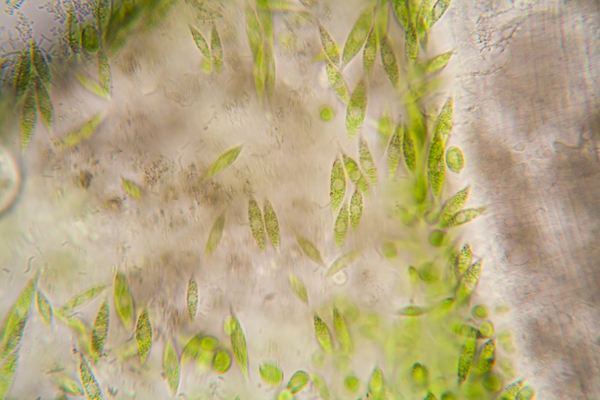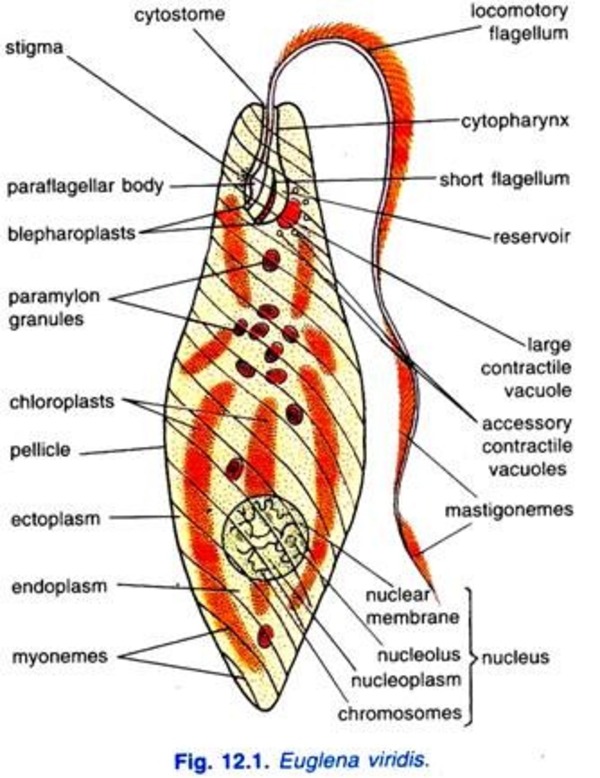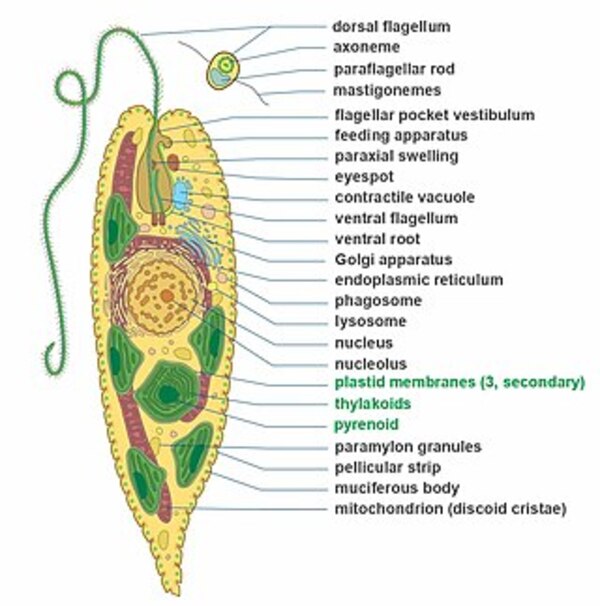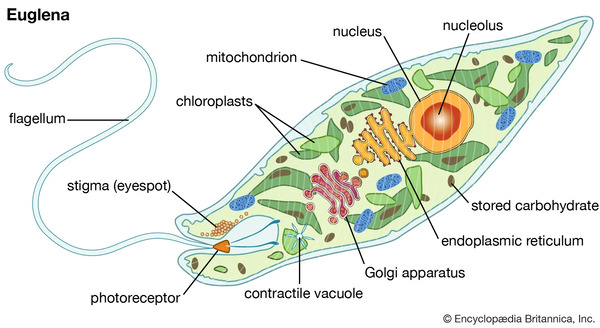Euglena is a fascinating single-celled microorganism commonly found in ponds and small bodies of water. These tiny creatures, often requiring a microscope for visibility, play essential roles in their ecosystems. Depending on the conditions, Euglena can behave like plants or animals, showcasing their unique adaptability.

Euglena contains chloroplasts, which allow it to harness sunlight to produce food through photosynthesis, similar to plants. This process gives Euglena its green color and contributes to the green surface scum often seen in ponds.
In contrast, Euglena can also act like animals. It moves using flagella (whip-like tails) and can consume organic matter when sunlight is unavailable, adapting its feeding habits based on environmental conditions.
Scientists have long debated whether Euglena should be classified as a plant or an animal due to its unique traits. This complexity highlights the challenges of categorizing organisms that exhibit characteristics of both kingdoms.
Euglena belongs to a group of microorganisms, some of which can cause diseases like sleeping sickness. Notably, Euglena gracilis has been extensively studied as a model organism to understand how living things respond to stress.
Euglena can change shape and possesses a distinctive red spot called a stigma, which helps it detect light. These features make it a captivating subject for scientific research.
Next time you see green scum on a pond, remember that it might be home to these remarkable shape-shifters, Euglena. Despite their small size, they play a significant role in the ecosystem of tiny organisms.
Euglena is a genus of single-celled microorganisms found in water, capable of photosynthesis and movement.
Euglenoids, a captivating group of unicellular organisms, exhibit diverse characteristics. Let’s explore their defining traits:
Structural Versatility:
Dual Nature: Euglenoids blend animal-like and plant-like features.
Evolutionary Complexity: More advanced than blue-green algae, they possess distinct nuclei and localized chlorophyll.
Habitat and Habits:
Diverse Environments: Euglenoids thrive in freshwater ponds, ditches, and moist soil.
Research Favorites: Euglena is a common choice for laboratory studies.
Nutritional Diversity:
Photosynthesis: Many euglenoids utilize sunlight for energy through chloroplasts.
Adaptable Feeding: They can adopt various nutritional modes, including saprobic and phagotrophic habits.
Reproductive Strategies:
Asexual Reproduction: Primarily through binary fission.
Cyst Formation: Under stress, they form protective cysts with robust membranes.
Domain: Eukaryota
Kingdom: Protista
Phylum: Euglenozoa
Class: Euglenoidea
Order: Euglenales
Family: Euglenaceae
Genus: Euglena
Species Diversity: The Euglena genus contains around 152 species.
Flagellated Movement: Equipped with flagella for movement.
Chloroplasts: Capable of photosynthesis, producing energy from sunlight.
Adaptable Diet: Can switch between plant-like and animal-like feeding strategies.
Remarkable Adaptability: Can lose chlorophyll under stress, altering its state.
Euglena is highly adaptable, thriving in various environments from freshwater to moist soils. Their blooms can turn pond surfaces red or green, indicating their presence. They can also survive extreme conditions, including high temperatures and acidic environments.

Euglena has a unique structure:
Elongated Shape: Ranging from 15 to 500 micrometers.
Pellicle: A flexible protein layer, allowing shape change.
Photosynthesis: Chloroplasts with three membranes, synthesizing paramylon as a food reserve.
Eyespot: Helps detect light for movement direction.
Flagella: Two flagella aid in locomotion and food intake.
Inside Euglena, various specialized structures work together for its functions, enabling it to thrive in diverse environments. This complex internal organization contributes to its unique adaptability and ecological significance.

Euglena is a fascinating microorganism with a unique structure that sets it apart from other organisms.
Elongated Shape: Euglena typically has a spindle-like form, ranging from 15 to 500 micrometers in length.
Pellicle and Flexibility: Instead of a rigid cell wall, it has a flexible pellicle made of protein, allowing it to change shape and maintain its structure.
Photosynthetic Abilities: Its chloroplasts, containing three membranes and pyrenoids, enable it to perform photosynthesis and store paramylon, a starch-like carbohydrate.
Eyespot and Photoreceptor: The eyespot, rich in carotenoid pigments, helps filter sunlight for the photoreceptor, aiding in light detection and movement.
Flagella for Locomotion: Euglena has two flagella—one long and one short—that assist in swimming and creating currents to draw in food.
Inside Euglena, various specialized structures collaborate to support its functions:
Pellicle: A flexible membrane that maintains shape.
Plasma Membrane: A selective barrier controlling substance exchange.
Cytoplasm: A jelly-like substance housing organelles.
Chloroplast: Contains chlorophyll for photosynthesis.
Nucleus: Houses genetic material and nucleolus for RNA synthesis.
Mitochondria: Produce ATP for energy.
Ribosomes: Synthesize proteins.
Golgi Apparatus: Processes and transports molecules.
Endoplasmic Reticulum (ER): Packages and transports proteins; can be rough or smooth.
Lysosomes: Break down large molecules.
Contractile Vacuole: Regulates water and salt balance.
Reservoir: Assists the contractile vacuole in expelling excess water.
Eyespot: Aids in light detection and navigation.
Photoreceptor (Paraflagellar Body): Influences movement in response to light.
Paramylon: Serves as a food reserve for survival in low light.
Euglena's intricate internal structure, combining plant and animal features, makes it a captivating subject for scientific study. Its ability to adapt, perform photosynthesis, and navigate its environment showcases the remarkable complexity of life at the microscopic level.
Euglena is fascinating not only for its photosynthetic abilities but also for its nutritional versatility. It utilizes chloroplasts inherited from a green algal ancestor to harness sunlight for energy. However, it requires additional nutrients like organic substances and vitamins, including vitamin B12, to thrive.
Some Euglena species can switch from autotrophy to heterotrophy, absorbing organic matter or engulfing bacteria when light is scarce. This adaptability extends to certain species that rely entirely on heterotrophic nutrition. Furthermore, Euglena synthesizes paramylon, a stored food reserve that provides energy when sunlight is unavailable.
Interestingly, some species produce euglenophycin, an alkaloid with toxic properties that can impact aquatic life while also showing potential as an anticancer agent.

Euglena's movement is guided by an eyespot that detects light, allowing it to engage in phototaxis. Light signals are processed by the photoreceptor, directing movement through two flagella, one short and one long. This arrangement facilitates agile swimming and responsiveness to environmental changes.
Euglena reproduces primarily through binary fission, where it divides into two daughter cells, and multiple fission, which can produce many offspring simultaneously. During unfavorable conditions, it can encyst itself for protection before undergoing these processes.
Euglena is classified as a mixotroph due to its dual nutritional capabilities, employing both autotrophic (photosynthetic) and saprotrophic (absorbing nutrients) strategies. This versatility enhances its survival and adaptability in varying environments.
While most Euglena species are benign, Euglena sanguinea is notable for producing the toxin euglenophycin, which can harm aquatic life. Research has linked this species to fish mortalities and highlighted its potential in cancer research, showcasing the dual nature of its toxicity.
Euglena plays crucial roles in ecosystems, biotechnology, and medicine. It contributes to nutrient cycling, serves as a model organism for scientific research, and has potential applications in biofuels and health supplements. Its ability to indicate water quality further underscores its ecological significance. Overall, Euglena exemplifies the complexity and utility of microorganisms in our world.
animal tags: Euglena
We created this article in conjunction with AI technology, then made sure it was fact-checked and edited by a Animals Top editor.